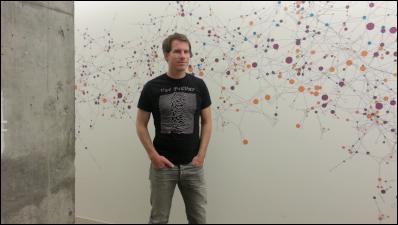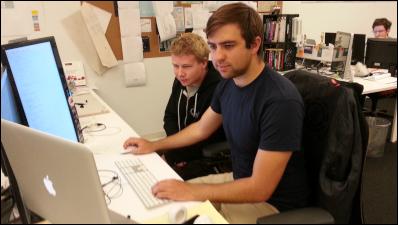Stateside With Rosalea : Quid
Stateside With Rosalea
Quid

Sean Gourley in the entrance to the Quid offices in San Francisco - Click for big version
Tucked away behind a park on the edge of San Francisco’s Financial District is a low-rise brick building that is home to the offices of Quid. If you haven’t heard of Quid before, 2013 might be the year to change all that when it rolls out the web version of its augmented intelligence software, hoping to challenge Google and Bing as a search platform, especially for topics that are in the news.
“Google says: Here’s the best story; here’s the list,” explains Sean Gourley, co-founder of Quid. What Quid’s software will allow a user to say, he continues, is “Instead of giving me the best story, give me every story. And instead of giving it to me as a list, give it to me as a map.”
“That is the metaphorical change here in the consumption of information. We’re not trying to guess the best story for you; we’re trying to give you a platform for you to understand the entirety of the landscape.”
Since its creation in 2009, Quid has been doing just that for enterprise users. Among the clients listed on its corporate website are Samsung, Intel, Microsoft, and Russia’s largest bank, Sderbank. While Gourley is understandably coy about what exactly these and other clients use Quid for, he says the software is usually deployed by strategy groups within a company. Dissatisfied with how anecdotal, political, and ad hoc most strategy approaches are, they’re seeking an alternative.
That alternative is augmented intelligence. If you’re not familiar with the term, you should watch Gourley’s TEDx Auckland presentation about it here. Basically, Quid’s software uses a computer to read thousands of documents, classify them according to their content and their relationship to other documents, and then return them to you as a “map of conversations”. (Or a map of intellectual properties, or a map of technologies, depending on what a company’s strategy group is focused on.)
You then use your human intelligence to navigate that map.
Let’s say you wanted to know about all the stories around cyber security. Other companies make data mining programs that bring back lists of all the relevant articles; lists that might be imported into an Excel file and then reordered according to the user’s needs. Quid generates that data file, but it also creates a visualization of it. You can adjust the settings so that you see, for example, which topics got the most attention, or you can trace a particular article back to the sources the reporter used and see who else was using those sources.

Data Visualisation vs Text - Click for big version - (Photo credit: Sean Gourley)
On the left is a visualization of the comma delimited file on the right, which would traditionally be loaded into an Excel spreadsheet. Only a small amount of the text file is visible because there are thousands of rows.
As Gourley shows me how Quid works, it is obvious that he thrives on complexity. He delights in manipulating the many parameters that can be set so that the data map draws the human eye in a way that lists cannot, even when the lists are sorted on some particular field.
“What we have here,” he explains about one map, “is a projection of different timelines across different source ranks, to see where ideas have moved through time in between different qualities of sources. These are the top sources; these are more of the blogs. You can see where the ideas resonate from.
“You can take a three-dimensional view of the news landscape through time. You can see where stories are resonating between sources through time. The human brain doesn't do this. That's the point. It's an incredibly complex world that we're trying to navigate, and we don't have the cognitive wherewithal to do it.”
But neither does a computer have the wherewithal to make the kind of reasoned choice the human mind is capable of. “There's no button to push to tell you: This is the story that I need to put out there to change the conversation around cyber security. We don't have algorithms to tell us that. But we do have tools that help us make better decisions around it.”
The combination of data mining and data visualization might seem rather removed from daily life, but it is a multi-billion dollar industry that affects what gets traction in the media, which small companies are snapped up by larger ones wanting to get ahead of the technology curve, and—I’m guessing—who gets poached from which company as the result of looking at a map of patent authors and the groups they are part of.

Click for big version
Sam Dalton and Joey Hobbs working on the web version of Quid
Gourley’s team, working out of converted warehouse space, is at the cutting edge of this “really cool way of interacting with information”. There are 42 people on staff, including four dedicated to sales. Quid’s growth since 2009 has been a combination of growth funded by venture capital and growth that is funded by dollars from the deals it makes with big clients.
When I ask if there’s a “lite” version of Quid for people like me, Gourley replies, “We have a Kiwi programmer working on just that solution. Joey is an Auckland University grad. He's working on the web version. We're pretty excited for a release of that this year, where instead of going to Google, you'll be able to go to Quid and you'll have all this information. That'll change things up pretty dramatically. This is going to be a big year for us.”
--Peace Out--


 Martin LeFevre - Meditations: Animal Encounters During Meditative States
Martin LeFevre - Meditations: Animal Encounters During Meditative States Ian Powell: Gisborne Hospital Senior Doctors Strike Highlights Important Health System Issues
Ian Powell: Gisborne Hospital Senior Doctors Strike Highlights Important Health System Issues Keith Rankin: Who, Neither Politician Nor Monarch, Executed 100,000 Civilians In A Single Night?
Keith Rankin: Who, Neither Politician Nor Monarch, Executed 100,000 Civilians In A Single Night? Eugene Doyle: Writing In The Time Of Genocide
Eugene Doyle: Writing In The Time Of Genocide Gordon Campbell: On Wealth Taxes And Capital Flight
Gordon Campbell: On Wealth Taxes And Capital Flight Ian Powell: Why New Zealand Should Recognise Palestine
Ian Powell: Why New Zealand Should Recognise Palestine